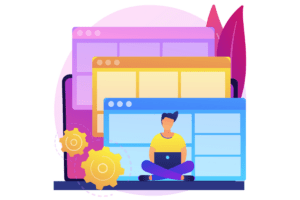Wow, 2022 was a whirlwind, and B2B marketing has changed a lot. There have been a lot of changes that we haven’t seen before – Facebook’s new algorithm changes, influencer marketing hitting $13.8 billion per year, and new tools popping up every day.
How can you keep track of all these changes, and stay ahead of the curve?
As a business owner, it’s important to know the key B2B marketing strategies and learn the skills associated with them to succeed and grow your business in 2024. Lucky for you, we created a list of all the top B2B marketing strategies that you should implement if you want to see tremendous growth in the coming year.
Let’s Look at These Top 6 B2B Marketing Strategies for 2024
1. Double Down on Marketing Automation
Marketing automation has really taken off in the last few years. It’s the perfect mix of inbound methodologies and analytics. It gives B2B marketing the power and the data to drive results and convert leads better.
According to Smart Insights, 18% of businesses are still not using marketing automation, and 46% are in the beginning stages of using it.

Automation is only starting to gain popularity, and it’s already very powerful.
There are a variety of strategies you can use. You can create a multi-step onboarding campaign that is based on dynamic content. For example, if a customer opens and reads email A, then they get email B. But if they never opened email A, then they will get email C.
You can use Marketo or Hubspot. Both are great for creating customer journeys, converting leads, and nurturing customers.

Another aspect of automation is social media automation. This is where you can use a social media tool like CoSchedule or Buffer or Sendible to automate your social media publishing, engagement, and brand monitoring.

Yet another form of automation you should implement for your business is streamlining all of your data collection and team collaboration. You can use a tool like Trello to help you organize notes, projects, and calendars, and combine it with Zapier or PieSync to collect data on your users and assign tasks to your team in real-time.

I know we covered a lot in just that one segment, but if you learn the basics of every type of automation you can easily train your team or hire freelancers. Automating your marketing, lead generation and capture, social media, and project documents and calendars will help you stay ahead in 2024.
Let’s talk about your brand.
What is the meat and potatoes of any good brand?
Why content of course!
2. Use Content Marketing to Attract the Convert Leads
Content has seen a huge overhaul in the last few years, all in the name of SEO. Only a few years back, Google took into account pretty much any backlink you would get to your site, regardless of quality.
Well, those times have changed.
Google is looking for high-quality backlinks and wants to see that your visitors are staying on your site and interacting with your content.
The current discussion about content marketing in 2024 is around finding the right balance of content quality, quantity, and frequency.
Here are some key tips on how B2B companies can benefit:
- Google ranks long-form content better. According to Neil Patel, if you can get above 3,000 words you’re golden.
- Consistency is key. Publish your content regularly on your own site or blog, and on all the various social media channels that you manage.
- Make sure that your content form and medium match the social media channel that you are using. Write stories on LinkedIn, use a lot of hashtags on Instagram, include long descriptions on Facebook and YouTube, and import your articles into Medium.
- Be authentic and transparent. Site visitors want to read the story of your company, including your successes, and failures. So don’t be shy. If you paint an authentic picture for your audience, it will become a loyal following and help boost all of your rankings.
- Attract the ideal customer with the right content. Create a comprehensive content strategy that revolves around your key customer personas and you will begin to see your ideal audience click and convert on your site.
If you use all these content marketing tips then your site will rank higher, you will get more visitors, and you will build an engaged following.
What is even better than having to build a loyal following?
Using someone else’s!
3. Reach the Ideal Audiences Using Influencer Marketing
Influencer marketing reached $13.8 billion in 2021 and is expected to continue to grow. Why? Because influencer marketing has shown to have 11X the ROI of any other marketing channel. And it receives 2X the number of impressions per campaign post.
It’s also much more powerful than social media advertising because each influencer has a specific audience that’s engaged and consumes their content regularly. When you hire that influencer, you get access to their audience.
How to use influencers to get more B2B leads:
- Use an influencer management tool like Grin or InsightPool to speed up finding an influencer and for better analytics of each campaign.
- Work with influencers whose audience matches yours. You can use Visitor Queue to find out exactly who your site visitors are. And then use an influencer tool or marketplace to find influencers with a similar audience to yours to target them.
- Hire a team of influencers to maximize your reach and develop long-term relationships with each one of them. The more brand ambassadors you have, the better.
- Create user-generated content campaigns where the users create their own content to promote your brand.
- Have your team of influencers create content tagging your brand and the selected hashtag(s) and see the magic happen.
- Analyze each piece of content of each campaign to track the engagement rate, traffic, and leads that each influencer contributed.
A lot of B2B companies really struggle with reach. Organic reach is historically low on social media channels like Facebook and paid reach on Google is getting more and more expensive. The best solution is to use an influencer, who already has a built-in audience, and reach out to that audience.
One of the most successful campaigns ever was executed by Microsoft. The company hired National Geographic, which has a total reach of over 86.5 million people on Instagram, to promote International Women’s Day. They hired several female adventure photographers to create stunning visuals that would tell stories about famous female explorers.
The whole campaign was meant to celebrate women’s contributions and to position Microsoft as the company that cares about the cause. They even used the catchy hashtag #MakeWhatsNext.
The campaign did incredibly well. The hashtag generated over 1,000 pieces of user-generated content and Microsoft got over 3.5 million likes and a reach of 91 million people. All in the span of a few days.

Be creative. Do an influencer campaign that engages the audience, encourages users to create their own content, and uses a catchy hashtag. Use influencer marketing to get traffic, reach, engagement, leads, conversions, and sales for your business.
4. Engage your customers through Chatbots and Artificial Intelligence
There are a bunch of new technologies that transform the user experience and revolutionize the way we interact with our world. Each one creates a new B2B marketing channel of its own that you should use to generate leads and convert them to paying customers.
Chatbots
Another emerging trend is using a chatbot to interact with your customers and social media followers.
Some customers prefer to purchase products and services using Facebook Messenger because they are on the go and because it’s a much more interactive experience. So brands are developing automated sequences and product recommendations that they can deliver through a chat message.
There are a lot of ways that you can use chatbots as a B2B marketer or a business owner.
First, use a chatbot to send out weekly content and engage with your followers. Andrew Warner of Mixergy does exactly that.
The advantage of using a chat message is that you can make it way more interactive than an email, and get 88% open rates and 56 click-through rates.
Here he is:

Would you click on a message like that?
I would.
Another great way to use a chatbot is by creating a chatbot subscription list. You can use a tool like ManyChat to create really cool-looking chatbot popups and landing pages that capture your site visitor’s information on Facebook Messenger.
Here’s an example of one:

Instead of trying to capture an email, which only gets 20% open rate, you can send a personalized interactive chat message, and get 4 times the open rate.
As soon as the visitor clicks on the blue button, they get added to your chat subscription list. You can then send them a chat message weekly, biweekly, or even monthly.
What else can you do with a chatbot?
You can launch a product!
One of the best examples of this is Josh Fechter’s The BAMF Bible which contains the top 25 growth hacks from 2017. He launched it on ProductHunt where it quickly became the number one upvoted ebook of all time. And guess what? He used a chatbot to do it.

Josh published several pieces of content on LinkedIn and Facebook which had a link to his ManyChat landing page. He was able to get 4,000 new subscribers on his Facebook Messenger subscription list just from this one book launch. Not too bad for new emerging technology.
Another reason to use chatbots is that you can acquire a ton of leads. Numerous chatbots help businesses get referrals from their customers. RewardStream, a lead generation chatbot, converted 30% of all the referral leads that their customers received within the first month and a half.

AI
Artificial intelligence is a super useful tool and an emerging trend in 2024. You can use artificial intelligence to gather data, automate processes, and deliver a better user experience.
One example is Statsbot, the chatbot that uses AI to display key data for your business.

Statsbot actually connects to your Google Analytics, SQL, Mixpanel, Stripe, and Salesforce to deliver updates about your data in real-time. And because it uses artificial intelligence, it can find data segments that are lacking in your business or a particular problem that you have overlooked.

5. Focus on the Customer Journey
Another great B2B strategy is to use omnichannel marketing to transform the customer journey. The nature of the customer journey is such that there are many more ways by which a customer can enter your sales funnel and purchase your product.
Sometimes, it starts with an email or a Facebook Messenger chat message. And then the customer gets reminded of your product through social or a digital banner. And then finally purchase your product on a mobile device on the go.
The idea is to ensure that there are multiple channels through which a B2B buyer can enter the sales funnel. And you’ll have to provide a good experience in each channel so the buyer can smoothly complete their journey with a purchase.
The following B2B buyer journey map from UXPressia can help you understand it better. You can raise awareness about your product or service through channels such as content and social media. At the same time, these channels can serve as a way to generate leads and create buying opportunities for your customers.

Next Up
You can never predict which channel is used for initial shopping and which is used for the final purchase of your product or service. This is why any business needs to master many B2B marketing channels. And develop consistency of their content and brand message throughout the customer journey.
One of the ways to develop consistency on all of your channels is through personalization. Personalization is key in today’s omnichannel world. Users want companies to save the information and create dynamic content with personalized suggestions.
For example, Evergage creates a wide variety of content to suit different audiences across various industries. So instead of promoting generic content across their site, they have a system for offering personalized content recommendations for each visitor. This enhances the customer experience across all devices for every single visitor.

6. Learn about Your Audience through a Website Tracking Tool
Data is probably the most powerful thing you can have in a B2B business. You need to know who your site visitors are – where they are from, what they are interested in. To learn about or purchase from you, and how they got to your site.
One of the best tools to use is Visitor Queue, an advanced B2B lead generation software acting like Google Analytics on steroids.
You can use Visitor Queue to capture the names, locations, and contact information of your website visitors. Also, check their social media accounts and see which specific pages the users have visited on your site.

Instead of putting up a bunch of popups and lead magnets and hoping to catch some big fish, get the right information about every visitor so you can re-engage with them and contact them to answer their specific concerns.
That’s the power of data and any B2B business must master it in 2024.
Recap
Here is a recap of are some of the top B2B marketing strategies to know for 2024:
1. Double Down on Marketing Automation – Use marketing automation tools to segment your customer base and increase your conversions. Utilize social media automation and project management tools to streamline all of your processes.
2. Use Content Marketing to Convert Leads – Experiment with long-form content, publish your content consistently, and tell your company’s story. Adjust your content to fit each social media platform to make it look native.
3. Reach the Ideal Audiences Using Influencer Marketing – Hire a team of influencers with engaged audiences to promote your product or service. Maximize the reach and engagement rate of every campaign by using catchy hashtags and promoting user-generated content.
4. Engage Your Customers with Chatbots and AI – Create chatbots to enhance your users’ experience and to create a new sales channel for those customers that prefer to shop on the go. Also, use artificial intelligence and virtual reality to bring your marketing to the next level.
5. Focus on the Customer Journey – Develop all of the various channels that your customers use throughout their customer journeys. Use personalization and dynamic content to make your website visitors feel at home.
6. Learn about Your Audience through a Website Tracking Tool – Collect essential information about your website visitors using a website tracking tool. You can then use this data to provide them with relevant offers that will engage them.
Wrap Up
If you master even one strategy on this list above, you will see a huge change in your business in 2024. The key is not to overdo it and try all these things all at once. Try one thing at a time, and A/B test it, analyze the results and continue on to the next project only when you’re satisfied.
 Identify
Identify Personalize
Personalize Benchmark
Benchmark Agencies
Agencies Integrations
Integrations Case Studies
Case Studies Use Cases
Use Cases Blog
Blog Resources
Resources









